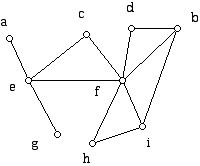
Review for Examination I
Mathematics 241
Prepared by:
Joseph Malkevitch
Department of Mathematics and Computer Studies
York College (CUNY)
Jamaica, New York 11451
1. Given the graph G below:

a. What is the degree of vertex e?
b. What is the valence of vertex f?
c. How many vertices does G have?
d. How many edges does G have?
e. Draw G - d.
f. Draw G - edge eg.
g. Write down the degree sequence of G.
h. Draw several graphs which have the same degree sequence as G and are not isomorphic to G.
i. Determine the chromatic number of G.
j. Draw a proper coloring of G which uses one more color than the chromatic number of G.
k. What is the independence number of G?
i. What is the clique number of G?
j. Draw the subgraph of G induced by the vertices in set: { c, e, f, i, h }.
k. Draw the subgraph of G induced by the vertices in set: { a, e, g }.
l. If P4 arises as an induced subgraph for some set of vertices of G, write down this set of vertices?
m. Does C4 arise as an induced subgraph for some set of vertices of G? If so write down a set of vertices which works.
n. Compute the edge connectivity of this graph.
o. Compute the vertex connectivity of this graph.
p. List all the cut vertices of the graph.
q. List all the bridges of G.
r. If G has an edge cut of size 2 write down the edges in this cut.
s. Find the distance between vertex a and vertex b.
t. Find the distance between f and i.
u. Find the distance from e to h.
v. Find the longest path from e to h.
w. Is there a path of length 3 from e to d? of length 4? of length 5?
x. Find the eccentricity of each vertex in G.
2. Draw a graph in the plane which has 6 vertices, 3 components and which includes edges which meet at points which are not vertices. Write down the degree sequence of the graph you draw.
3. Can there be graphs with the degrees below? If so, draw the graph, if not give a reason no such graph exists.
a. 4, 4, 4, 4, 4, 4, 4.
b. 4, 4, 4, 4, 4, 4.
c. 3, 3, 3, 3, 3, 3, 3.
d. 3, 3, 3, 3, 3, 3.
e. 5, 5, 4, 3, 3, 3, 2, 1.
f. 10, 3, 3, 3, 3, 3, 3, 2.
4. Draw as many non-isomorphic trees as you are able to with 6 vertices.
5. Find the central vertices for graph G in problem 1.
6. Find the center for the graph G in problem 1.
7. Can a graph be isomorphic to its center? If so, draw an example.
8. State Jordan's Theorem for what the structure of the center of a tree must be.
9. Prove that if one sums the degrees of the vertices of a graph that the result is twice the number of edges of the graph.
10. Draw a graph which is not a tree but where every edge is a bridge.
11. Are there graphs for which the number of vertices is one more than the number of edges but which are not trees? If such graphs exist, draw an example.
12. Suppose G is a connected graph, and let x be one of its vertices. Let y be the vertex of G which is farthest away from x. Must the eccentricity of x be the same as the eccentricity of y? If not draw an example where the two vertices can have different eccentricity.